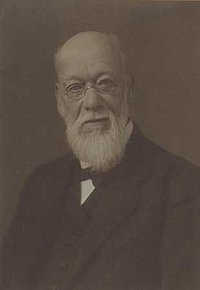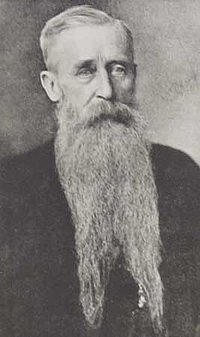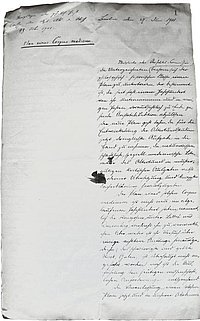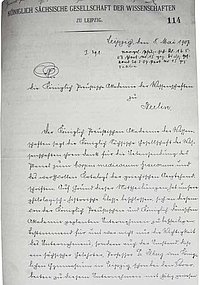
Until the middle of the 19th century, academic interest in ancient medical texts was largely limited to medical practitioners. The texts belonged to a body of literature considered relevant from a professional point of view. Consequently, they were edited by physicians for use by other physicians. Under these conditions, the application of the text-critical methods of classical philology was severely restricted. A prominent example of this sort of edition is that of the collected works of the Greek physicians (Medicorum Graecorum Opera quae exstant), edited by Carl Gottlob Kühn, professor of physiology and pathology at the Universität Leipzig. Between 1821 and 1833, Galen, Hippokrates, Aretaios and Dioskurides were published within the framework of this edition. As far as Galen is concerned, the Kühn edition is today, in spite of its shortcomings, still to a large extent the definitive edition. In content and textual arrangement, it essentially constitutes a reprint of the edition published in Paris by R. Chartier in 1679.
In 1869, faced with a situation in which Kühn’s text was to be used as a basis for the resolution of a source-critical problem, Hermann Diels, while still a student, found that the text, due to later additions, was completely useless as a historical source. His study of other editions of medical writings further confirmed the fact that the level of textual authenticity was far from what could be attained through a philological examination of the extant texts. This knowledge awoke in him the desire to create a usable medical corpus.

An opportunity to realize this goal presented itself to Diels in 1901, when the Danish scholar Johan Ludvig Heiberg, during the first general meeting of the International Association of Academies in Paris, proposed to him the publication of a corpus of ancient medical writings that would meet the requirements of modern textual criticism, as a joint venture of the Berlin and Copenhagen Academies.
Three months after his conversation with Heiberg, Diels was already presenting the philosophical-historical department of the Berlin Academy with the first plan for the Corpus medicum. He was assisted in his preparations by Hermann Schöne, who had demonstrated his competence for the job through academic publications in the field of ancient medicine. At the department meeting, Diels asserted that the planned undertaking coincided with the interests of the physics and mathematics department as well, because he held the existence of the Corpus to be an indispensable prerequisite for research into the history of ancient medicine. The first step in realizing the plan was to record and catalogue all of the manuscripts containing ancient medical texts available in European libraries, not only Greek and Latin originals, but also Latin, Syriac, Arabic and Hebrew translations. Schöne played a crucial role in this preparatory work as well, through his conceptual considerations and his journeys to libraries in Italy and France.

Diels entrusted the final production of the manuscript for the catalogues and the supervision of printing to his student Johannes Mewaldt, after Schöne had declined the assignment. Publication of the catalogues of Greek medical manuscripts in 1905 and 1906, together with the consent of the third general assembly of the International Association of Academies, paved the way for work on the Corpus Medicorum Graecorum (CMG) to begin in 1907.
Recommended by Diels, Mewaldt was engaged as the Corpus’ first “Redaktor”; he performed this function from 1907 to 1933, during which period he was entrusted with management of the undertaking. Prior to the founding of the CMG, the Sächsische Gesellschaft der Wissenschaften in Leipzig had expressed its willingness to collaborate in the undertaking, with the result that the Berlin, Copenhagen and Leipzig academies bore collective responsibility for the publication of the Corpus. Central coordination was overseen from the beginning by the Berlin academy. In 1905, responsibility for the Latin series, the Corpus Medicorum Latinorum (CML) was entrusted to the Puschmann Foundation of the Universität Leipzig, but the Berlin Academy gained control of this project in 1957.
As Mewaldt’s successor, Karl Deichgräber served as “Redaktor” until the end of the Second World War. Special credit for rebuilding the project after the war is due to Konrad Schubring, who headed the workgroup from 1946 to 1961. Following Schubring, Jutta Kollesch led the project from 1961 to 1998. Her nearly four decades of effective activity at the post have left a lasting impression. She was followed by Diethard Nickel, who served as project manager from 1999 to 2004, and Christian Brockmann, who filled the post from 2005 to 2008 and has since been succeeded by Roland Wittwer.
A particular difficulty which the editors of the ancient medical corpus are confronted with even today consists in the fact that there are relatively few classical philologists in the world with the specialized knowledge required for the editing of medical texts. Because of this, the project was planned from its inception with international cooperation in mind. Over the previous decades, the number of foreign collaborators working on the Corpora has risen significantly. Throughout this period, researchers from Belgium, England, France, Italy, Canada, Sweden, Switzerland, Spain, Hungary and the USA have joined the project as collaborators on text editions.
In his preliminary conceptual considerations regarding the establishment of the ancient medical corpus, Diels had already expressed his intention that the published texts should include modern-language translations and brief elucidations in order to make the source texts accessible also to readers not sufficiently well versed in ancient languages.
In realizing this goal, top priority was to be given to the needs of medical historians. However, this plan could not be realized at first. Due to the changing educational situation, the relevant considerations were taken up decades later; in 1965, at a meeting of the Standing Commission of the Corpus Medicorum Graecorum, a decision was made to publish the texts of both series with translations. The choice of German, English, French and Italian as target languages was made, on the one hand, to allow the majority of foreign collaborators the opportunity to translate the texts on which they were working into their native languages; on the other hand, the languages chosen were those which would make the ancient medical texts accessible to the largest possible group of potential readers. With the introduction of translations, the previously binding guideline dictating that the introductions should be written in Latin was dropped.
In 1963, the main series of the Corpus Medicorum Graecorum was expanded to include a special “Supplementum Orientale”, in which Greek medical writings that have survived solely in oriental translations are made available. In 1994, a conversion took place from book production using traditional methods to a computer-supported and workplace-based method using camera-ready printing templates.




